

Insta360 X3: handy on fair-weather trips
The Insta360 X3 is uncomplicated and has countless settings. I used it to make high-resolution memory videos for a round trip. But as a holiday companion, it also has its weaknesses.
I took the Insta360 on holiday to Mexico. Because I see many advantages in an action camera like this for holiday trips. For example, it is handy and waterproof. In addition, the Insta360 comes with an image stabiliser, which is especially important on the bumpy roads and hikes in rough terrain. With 360-degree shooting, I also don't have to decide in advance which direction I want to film in. Seems perfect to be able to enjoy the view while filming.
I also prefer to take videos rather than photos when I'm on holiday. For me, the overall impression of a place or an experience is quickly lost if it only has to fit into pictures. Films have a completely different effect.
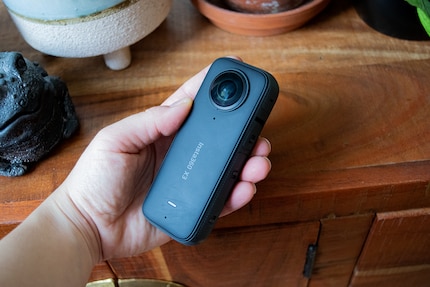
Source: Michelle Brändle
Specifications: Insta360 One X2 and X3 in comparison
With the predecessor model, the Insta360 One X2, the operation on the round, small screen is quite fiddly and I therefore need a smartphone for the control. With the X3, the operation on the large rectangular screen is clear and simple. The videos can then be edited on the computer or smartphone.
Otherwise, not much has changed from the X2 to the X3. At 180 grams, the X3 is slightly heavier than the previous 149 grams - but it still feels light in the hand. The functions remain the same, as do the video resolutions. The aperture is f/2 on the X2 and f/1.9 on the X3. The battery on the X3 is 1800 mAh, which is larger than the 1630 mAh of the One X2. The battery life remains at around 80 minutes. The video data rate has increased from a maximum of 100 megabits per second to 120. However, the camera also needs enough memory for all the information. That's why you should think about a fast microSD card with at least 128 GB of storage.
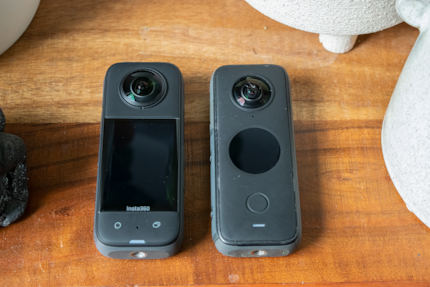
Source: Michelle Brändle
The setting options are the same on both and seem almost endless to me: photos and videos via single lens or in 360-degree mode. From 3K resolution to 5.7K - in static time-lapse it's even 8K - and frame rates between 24 fps and 100 fps. From linear and wide angle to ultra wide angle and maximum angle with distortion. Not quite all settings are compatible with each other. Depending on the resolution, the frame rate can be turned up less.
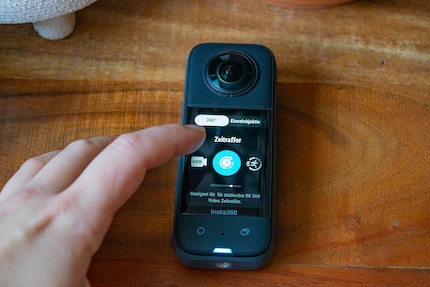
Source: Michelle Brändle
The editing programme from Insta360
It is only through post-processing that a 360-degree video becomes a normal video. The Insta360 editing programme can be downloaded from Insta360 using the camera product number via the website. The programme is clearly structured. You have the possibility to roughly edit your videos in order to be able to create export files for the finishing touches. That's why the programme also provides you with plug-ins for Adobe Premiere. And a guide for that. I'll focus on what the camera itself can do and how far I can get with Insta360's editing programme. As an introduction to the software, I recommend the following video.
With the all-round videos, you first select the desired section in the editing programme. This can be cut cleanly with two clicks. With keyframes you define the viewing direction and the angle at which the section is to be displayed. From a normal front view to a so-called "Tiny Planet", where it looks as if you are wandering around on a mini planet.
The software also offers time lapse, slow motion and object tracking. Colour optimisation is possible over the entire video with one click. And last but not least, you can reduce noise when rendering the videos.
Suitable for travelling: the editing programme for mobile phones
If you want to finish a few videos on the go and don't want to wait until you have a PC at your disposal, there is also an Insta360 app for iOS and Android. With it, you can access all the videos you've made directly and edit them in the smartphone app. The possibilities are as extensive as on the computer and offer easy operation adapted to smartphones.
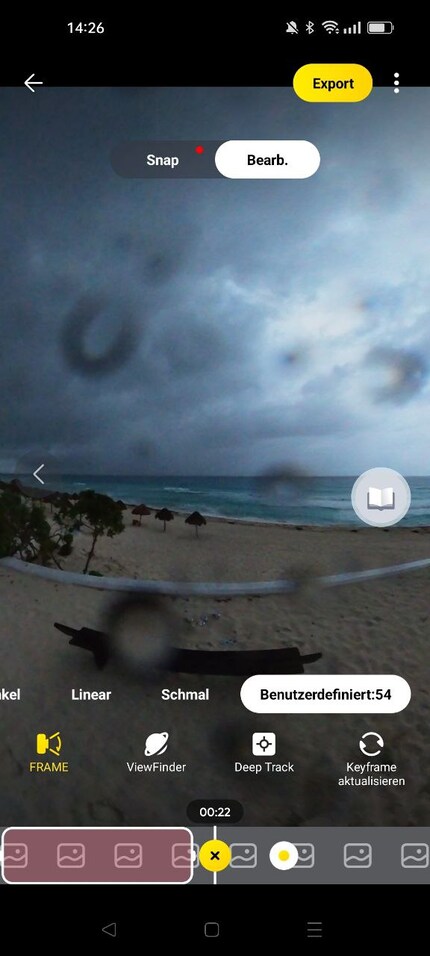
Source: Michelle Brändle
Here, for example, you can easily place different video clips next to each other and move them around. The video below explains the possibilities in more detail.
Showmanship: the camera as a travel companion
During our round trip in Mexico, we landed on beautiful beaches, explored the depths of the water and crossed some exciting places by car in between. With the Insta360 X3, I could always concentrate on the surroundings and didn't have to worry about getting everything on video. So I sometimes just strapped the Insta360 X3 to my backpack or to the car and only worried about the result afterwards.
Tourists are always the others: optimal conditions
The classic example of a holiday video: exciting monuments, lots of tourists and nice weather. How does that look with the Insta360 X3? In the editing programme I have the possibility to focus on the most beautiful spots. Without big effects and settings, I get a nice impression of the visited places in optimal conditions and already with 4K resolution.
The automatic image stabiliser works pretty well for such a bumpy footpath. The image has strong, natural colours even without post-processing. Everything that is in motion and a little further away looks not quite sharp. Despite the most natural possible angle of view, the sky is unnaturally distorted at the sides. To review the overall impression and the exciting place, I think the result is successful.
Atmosphere in rain and low light
In this video I show how the X3 handles rain and cloudy skies. The rain itself is not visible. But unfortunately the drops on the lens are. Fortunately, the camera is waterproof.
I am not convinced by the image quality in these light and weather conditions. The video is in 4K, but I would hardly have got more out of it at 5.7K. Even the noise reduction of the editing programme does not improve the dull picture. The image stabilisation is surprisingly good here. So walking across the sandy beach is no problem for the camera.
Atmosphere at sunrise
With changing light conditions, here as an example with a sunrise, the camera has a little less trouble. However, the dark areas lack gradations. The picture also appears dull in places. For such rather tricky conditions, however, the result is quite nice. The time-lapse added afterwards brings some variety.
On the road with the car
With an additional suction cup I also slapped the Insta360 onto the car. This way I could capture the surroundings during the long drives.
In the editing programme I can use an object tracker. If I mark the desired object, like a small hut at the side of the road in my example, it looks as if I am looking behind the object. With time-lapse, the objects on the side are given an additional filter by the AI, which increases the motion blur even more. So it looks like we are racing through the landscape.
The conditions for this have to be right, though. My first attempt at tracking an object was with a passing motorbike and didn't work. This could be due to the fact that I filmed from the car and thus the speed of the object was too high, but also because the motorbike in the shadow had too little contrast to its background.
The general video quality was also affected by the speed and the uneven ground. The image stabiliser had to correct a lot. You can see this in the following videos. The roads in Mexico were a wild roller coaster ride with countless potholes. In the first video I corrected it with the help of the editing programme (Flow-State), below is the same video without the stabiliser: Here it jerks for all it's worth.
Timeshift: time-lapse in motion
I also found the result of the camera's integrated time-lapse mode (Timeshift) exciting. In the upper video with the sunrise, I added this afterwards. The result here with timeshift is also smooth. The advantage is that I can save storage space with timeshift. I produce less data in advance for the same playback length as if I only put a long video into time-lapse afterwards. However, in my eyes it is much too fast and cannot be slowed down afterwards without severe loss of quality.
There is also the option of a stationary time-lapse on the camera. I didn't use this for my travel videos, but you could also set the speed there. With the stationary one, you need a tripod and can then record a 360-degree shot over a longer period of time as a time-lapse. With timeshift, you are in motion while filming.
Wet affair: The X3 with case in the deep end
The most exciting application was in the depths of a cenote. That's what natural water sources are called in Mexico, usually formed by the collapse of caves. There are rare varieties where fish and turtles live, and we visited one of them.
While snorkelling, I wanted to find out what the action cam, which is waterproof to 10 metres, could capture and what the quality was like with the additionally available diving cover. With the case, I should also be able to dive down to 50 metres.
Here's a tip: If possible, the case should be mounted in dry conditions. Because even with small drops, the case tarnishes quickly and the underwater film becomes more of a fog film. For this reason, water-absorbent fabric strips are included with the diving case, which you should definitely use. And the case is susceptible to scratches, mine looked badly damaged after two weeks.
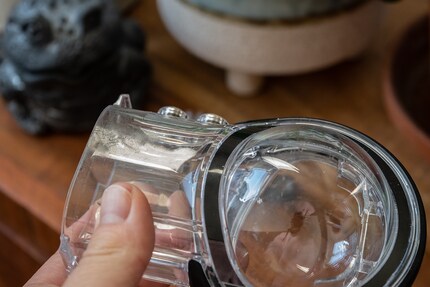
Source: Michelle Brändle
I had also forgotten to activate the Case mode on the camera, in fact the editing program detected it afterwards. The AI didn't cut the case out cleanly everywhere, though. With the right cut-outs, however, I managed to get a few nice clips. Most of the time there was little light, which is why those videos were quite grainy. Here you can see a Tortugita, a small freshwater turtle that we discovered while snorkelling.
Because the Insta360 X3 is waterproof to 10 metres even without a case, I then shot videos purely with the camera underwater to show the difference. In short, I would advise against it. Unfortunately, the image becomes blurred. The atmosphere created by the refracted light under water has something artistic about it and I really like it. Therefore, I would like to show you an example here.
Standing still: Photos instead of films
Besides videos, you can of course also take photos as JPEGs and in RAW format. And from the videos themselves, you can also create screenshots as photo substitutes by pressing a button in the editing programme. The quality of the video stills bothers me; the pictures are quickly blurred when you zoom in. And here, too, the lighting has to be right, of course. However, I have found a slightly grainy but atmospherically beautiful example of the screenshot variant.
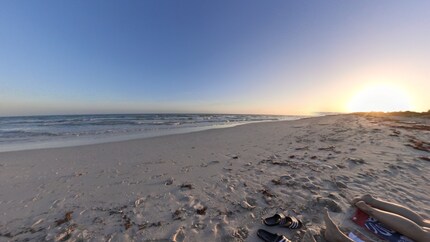
Source: Michelle Brändle
But how is the quality of a photo with the Insta360? Rather poor. Actually, it's the same as with videos. That means you need the best lighting conditions and you also have to hope that your subject is in focus and not overexposed. That's why I get a lot of messy results. The others didn't really differ from video screenshots.
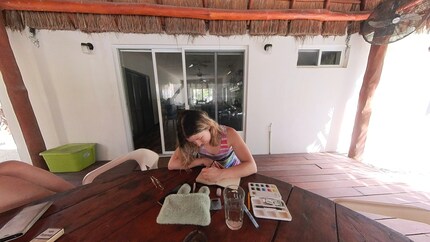
Source: Dominik Kirnbauer
The nice thing is that with 360-degree photos you can also decide which crop and angle you want to take. There, however, the edges are slightly distorted depending on the cropping.
Conclusion: Convinces me when the sun is shining
The possibilities with the Insta360 X3 are incredibly versatile and leave room for creativity. It is easy to use and fits in a small luggage. With a spare battery and plenty of memory on a microSD, you can also shoot longer films. For holidays, however, you should use it extensively, especially in good weather, and film in at least 4K resolution. If it is darker than in sunshine, the quality of the videos will quickly deteriorate.
The image stabiliser works very well in most cases, even on foot and on extremely bumpy roads. If the camera has to correct a lot of jerkiness, the picture quality is somewhat lower. When diving, you should definitely only enter the water with Case for clear results.
The editing programme is easy to use for both the smartphone and the PC and offers you many options for post-processing. This keeps the effort within reasonable limits and is even fun. Even the less good clips had their charm, captured our shenanigans and conversations and are definitely a great memory for later.
For 540 francs or euros, you get a compact, waterproof 360-degree video camera with many setting options. The X3 has only a few improvements over the One X2, but the more pleasant operation is definitely a plus. The One X2 currently costs just under 400 francs or euros (as of 05.04.23).
In my world, Super Mario chases Stormtroopers with a unicorn and Harley Quinn mixes cocktails for Eddie and Peter at the beach bar. Wherever I can live out my creativity, my fingers tingle. Or maybe it's because nothing flows through my veins but chocolate, glitter and coffee.



